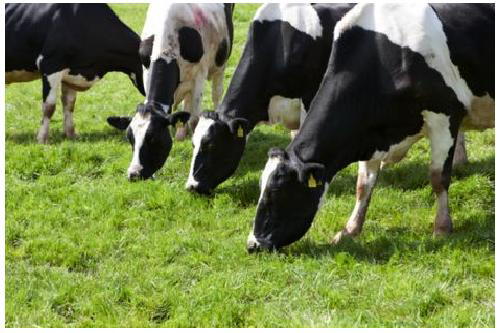Large impact of grass quality on methane emission

The quality of grass herbage and grass silage significantly affects enteric methane production of dairy cattle, according to new research of Wageningen UR in the Netherlands.
A considerable reduction in methane emission can be realised by shortening the grass regrowth interval. Improving grass quality is a practical measure with large potential for dairy farmers aiming to mitigate methane emissions. The studies were carried out by Wageningen researchers as part of the innovation programme Low-Emission Animal Feed.
Measure impact on methane
In dairy farming, methane contributes most to the global warming impact of milk production. The ‘Clean and Efficient’ covenant between the Dutch government and the agricultural stakeholders requires a reduction of greenhouse gas emissions by 30% by 2020 compared to 1990 levels. To help achieve this reduction, the Dutch Dairy Board, the Product Board Animal Feed and the Ministry of Economic Affairs funded the innovation programme Low-Emission Animal Feed. In this programme, researchers accurately measure the impact of diet on enteric methane production of dairy cattle in respiration chambers. Results of this research are exchanged with other national projects including ‘Cows and Opportunities’, and results are also used to develop practical tools including ‘Carbon Feed Print’ and ‘Annual Nutrient Cycling Assessment’ to help farmers cut their contribution to climate change.
Grass quality and methane production
The major share of feed intake by dairy cattle involves grass herbage and grass silage. Thus it is essential to have quantitative knowledge on the impact of grass quality on methane production. Despite the importance of grass, data on this impact actually is rather scarce worldwide. Available data has frequently been obtained using experimental methods with a low accuracy, and it is widely assumed that grass quality has no or only minor impact on enteric methane production. However, results of an advanced simulation model of fermentation processes in cattle developed by Wageningen researchers indicated large differences in methane production with various grass qualities. Therefore, a series of experiments were conducted in climate respiration chambers.
Effect on grass maturity
The results show that an increased grass maturity at harvest significantly increases methane production per kg of milk (milk expressed as fat- and protein corrected milk). Methane production of dairy cattle fed early-cut grass silage was up to 30% lower per kg milk than that of silage made from grass cut at a later stage of maturity. Similarly, high fertilised and less mature grass herbage reduced enteric methane production per kg milk, compared with low fertilised, more mature grass herbage. Improving quality of grass, fed either fresh or ensiled, has large potential for dairy farmers aiming to mitigate methane emissions.
The research was carried out by PhD research workers Sabrina Podesta, Geronda Klop, Bayissa Hatew and Daniel Warner. The advanced simulation model of fermentation processes is used in the National Dutch Greenhouse Gas Emission Inventory.











